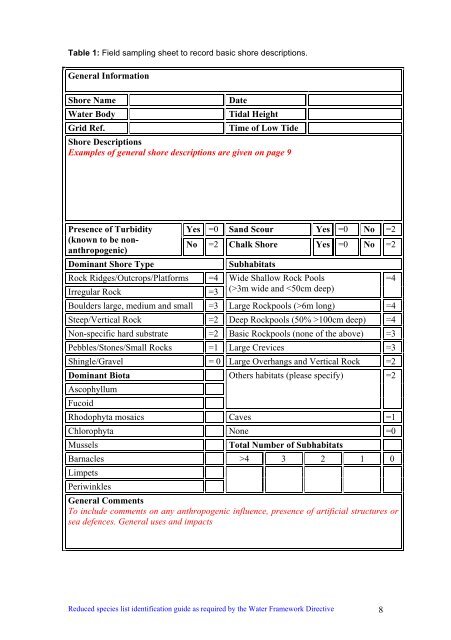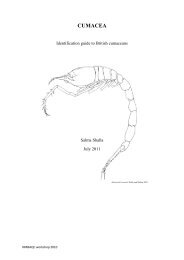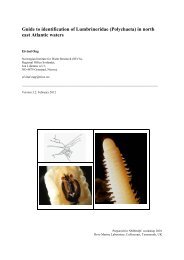s A Field Guide to the British Seaweeds - NMBAQC
s A Field Guide to the British Seaweeds - NMBAQC
s A Field Guide to the British Seaweeds - NMBAQC
You also want an ePaper? Increase the reach of your titles
YUMPU automatically turns print PDFs into web optimized ePapers that Google loves.
Table 1: <strong>Field</strong> sampling sheet <strong>to</strong> record basic shore descriptions.<br />
General Information<br />
Shore Name Date<br />
Water Body Tidal Height<br />
Grid Ref. Time of Low Tide<br />
Shore Descriptions<br />
Examples of general shore descriptions are given on page 9<br />
Presence of Turbidity Yes =0 Sand Scour Yes =0 No =2<br />
(known <strong>to</strong> be nonanthropogenic)<br />
No =2 Chalk Shore Yes =0 No =2<br />
Dominant Shore Type Subhabitats<br />
Rock Ridges/Outcrops/Platforms =4 Wide Shallow Rock Pools<br />
=4<br />
Irregular Rock =3 (>3m wide and 6m long) =4<br />
Steep/Vertical Rock =2 Deep Rockpools (50% >100cm deep) =4<br />
Non-specific hard substrate =2 Basic Rockpools (none of <strong>the</strong> above) =3<br />
Pebbles/S<strong>to</strong>nes/Small Rocks =1 Large Crevices =3<br />
Shingle/Gravel = 0 Large Overhangs and Vertical Rock =2<br />
Dominant Biota<br />
Ascophyllum<br />
Fucoid<br />
O<strong>the</strong>rs habitats (please specify) =2<br />
Rhodophyta mosaics Caves =1<br />
Chlorophyta None =0<br />
Mussels Total Number of Subhabitats<br />
Barnacles<br />
Limpets<br />
Periwinkles<br />
General Comments<br />
>4 3 2 1 0<br />
To include comments on any anthropogenic influence, presence of artificial structures or<br />
sea defences. General uses and impacts<br />
Reduced species list identification guide as required by <strong>the</strong> Water Framework Directive 8




